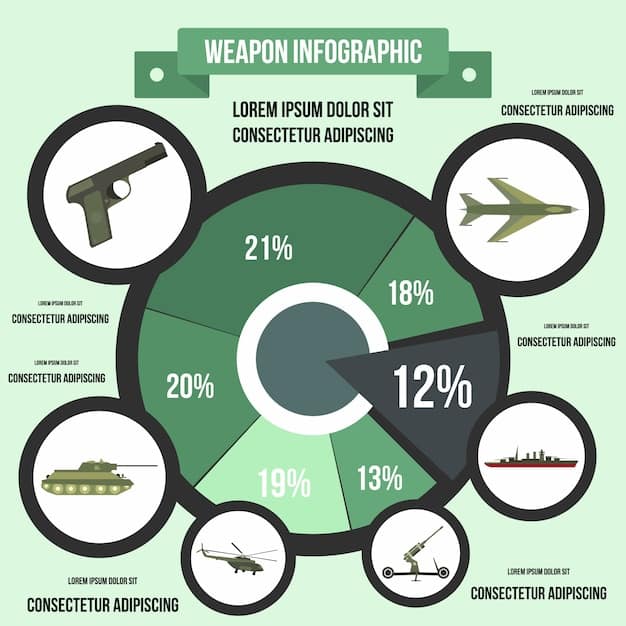State Gun Control Laws: Proposals and Potential Impacts in the US

State gun control laws encompass a variety of regulations at the state level in the US, including background checks, restrictions on certain firearms, and red flag laws, all aimed at reducing gun violence, but their effectiveness and impact on crime rates are subjects of ongoing debate.
Navigating the complex landscape of state gun control laws: What’s being proposed and what are the potential impacts? across the United States is crucial for understanding the evolving debate over firearm regulation.
Understanding the Current Landscape of State Gun Control Laws
State gun control laws in the United States vary widely, reflecting diverse political ideologies and public safety concerns. These laws address issues such as background checks, permits, assault weapons bans, and red flag laws, each with its own level of stringency and enforcement.
The effectiveness of these laws in reducing gun violence is a subject of ongoing debate. Proponents argue that stricter regulations can help prevent firearms from falling into the wrong hands, while opponents contend that such laws infringe upon the Second Amendment rights of law-abiding citizens.
Key Types of State Gun Control Laws
State gun control laws can be broadly categorized into several types, each targeting different aspects of firearm ownership and use.
- Background Checks: Laws requiring background checks for all firearm sales, including those between private individuals, aim to prevent prohibited persons from acquiring guns.
- Permit Requirements: Some states require individuals to obtain a permit before purchasing or carrying a firearm, often involving training, fingerprinting, and a background check.
- Assault Weapons Bans: These laws restrict the sale and possession of certain types of firearms deemed to be “assault weapons,” often based on specific features.
- Red Flag Laws: Also known as extreme risk protection orders, these laws allow temporary removal of firearms from individuals deemed a danger to themselves or others.

The patchwork of state gun control laws creates a complex legal environment for gun owners and policymakers alike. Understanding the specific laws in each state is essential for responsible firearm ownership and informed participation in the ongoing debate over gun control.
Proposed Gun Control Legislation in Various States
Across the United States, numerous states are considering or have recently enacted new gun control legislation. These proposals reflect a range of approaches, from tightening existing regulations to enacting entirely new restrictions on firearms.
These legislative efforts often stem from specific incidents of gun violence, as well as broader concerns about public safety. Understanding the details of these proposals is crucial for assessing their potential impact on gun ownership and crime rates.
Examples of Proposed Legislation
- Universal Background Checks: Several states are considering expanding background check requirements to include all firearm sales, regardless of the seller.
- Restrictions on High-Capacity Magazines: Some states are proposing bans on the sale and possession of magazines that hold more than a certain number of rounds.
- Increased Age Restrictions: Legislation to raise the minimum age for purchasing certain types of firearms is being considered in several states.
The success of these legislative efforts often depends on the political climate in each state, as well as the advocacy efforts of gun control and gun rights groups. The debate over these proposals is likely to continue for the foreseeable future.
Potential Impacts on Gun Violence and Crime Rates
Assessing the potential impacts of state gun control laws on gun violence and crime rates is a complex undertaking. Studies on the effectiveness of various gun control measures have yielded mixed results, with some showing a correlation between stricter laws and lower rates of gun violence, while others find little or no impact.
Understanding the nuances of these studies is essential for drawing informed conclusions about the potential effects of specific gun control laws.
Factors to Consider When Assessing Impact
- Enforcement: The effectiveness of gun control laws depends heavily on their enforcement. Lax enforcement can undermine the intended effects of even the strictest regulations.
- Cultural Factors: Gun culture and attitudes toward firearms vary significantly across states and regions. These cultural factors can influence the impact of gun control laws.
- Socioeconomic Factors: Poverty, inequality, and access to mental health care can all play a role in gun violence. Addressing these underlying issues may be necessary to achieve meaningful reductions in gun violence.

Moreover, the implementation of new laws is not without its challenges and criticisms. Opponents of stricter gun control often argue that such measures disproportionately affect law-abiding citizens and fail to address the root causes of violence. Understanding these counterarguments is crucial for a balanced view of the issue.
The Second Amendment and Legal Challenges
The Second Amendment to the United States Constitution guarantees the right to keep and bear arms, but the scope of this right is subject to ongoing legal interpretation. State gun control laws often face legal challenges based on Second Amendment grounds, with courts tasked with balancing the right to bear arms with the government’s interest in promoting public safety.
Understanding the legal landscape surrounding the Second Amendment is crucial for assessing the constitutionality of state gun control laws.
Key Supreme Court Cases
- District of Columbia v. Heller (2008): Affirmed the individual right to possess firearms for traditionally lawful purposes, such as self-defense in the home.
- McDonald v. City of Chicago (2010): Applied the Second Amendment to the states, limiting their ability to infringe upon the right to bear arms.
- New York State Rifle & Pistol Association, Inc. v. Bruen (2022): Established that gun control regulations must be consistent with the Second Amendment’s text and historical understanding.
These landmark cases have shaped the legal framework for gun control in the United States, providing guidance to lower courts in evaluating the constitutionality of state laws. The legal landscape is constantly evolving as new cases are litigated and new laws are challenged.
Economic and Social Costs of Gun Violence
Beyond the immediate tragedy of lives lost or injured, gun violence imposes significant economic and social costs on society. These costs include medical expenses, lost productivity, criminal justice expenditures, and the psychological trauma experienced by victims, families, and communities.
Understanding the full extent of these costs is essential for making informed decisions about gun control policies.
Economic Costs
The economic costs of gun violence are substantial, encompassing direct expenses such as medical care and law enforcement, as well as indirect costs such as lost wages and reduced economic activity. Studies have estimated that gun violence costs the United States billions of dollars each year.
These economic burdens are not evenly distributed, with some communities bearing a disproportionate share of the costs. Addressing gun violence can lead to significant economic benefits for these communities.
Social Costs
The social costs of gun violence are more difficult to quantify, but they are no less significant. These costs include the psychological trauma experienced by victims and their families, the fear and anxiety that pervade communities affected by gun violence, and the erosion of social trust.
Gun violence can also have a ripple effect, leading to increased rates of crime, substance abuse, and mental health problems. Addressing gun violence requires a comprehensive approach that takes into account these social costs.
The Role of Mental Health in Gun Violence
The relationship between mental health and gun violence is complex and often misunderstood. While it is true that individuals with certain mental illnesses may be at a higher risk of violence, the vast majority of people with mental health conditions are not violent.
Understanding the nuances of this relationship is essential for developing effective strategies to reduce gun violence.
Addressing Mental Health Concerns
Improving access to mental health care is crucial for preventing gun violence. This includes expanding insurance coverage for mental health services, increasing the number of mental health professionals, and reducing the stigma associated with seeking treatment.
- Early Intervention: Identifying and treating mental health problems early on can help prevent escalation to violence.
- Crisis Intervention: Providing immediate support to individuals experiencing a mental health crisis can help de-escalate potentially dangerous situations.
- Collaboration: Collaboration between law enforcement, mental health professionals, and community organizations is essential for developing effective prevention strategies.
The debate over gun control in the United States is deeply intertwined with questions about individual liberties, public safety, and the role of government. Finding common ground and developing effective solutions requires a commitment to evidence-based policymaking and a willingness to engage in respectful dialogue.
| Key Point | Brief Description |
|---|---|
| 🛡️ State Variations | Gun control laws differ significantly across US states. |
| ⚖️ Legal Challenges | Laws often face Second Amendment-based lawsuits. |
| 💸 Economic Costs | Gun violence results in large economic burdens. |
| 🧠 Mental Health | Mental health care access is vital in prevention. |
Frequently Asked Questions
▼
Red flag laws, or extreme risk protection orders, allow temporary removal of firearms from individuals deemed a danger to themselves or others, usually after a court order.
▼
Background checks involve verifying if a potential buyer is legally allowed to own a firearm by checking criminal records and other databases through the National Instant Criminal Background Check System (NICS).
▼
An assault weapon ban restricts the sale and possession of certain semi-automatic firearms based on specific features, such as detachable magazines and pistol grips, that are deemed military-style.
▼
Studies on the impact of gun control laws on crime rates vary, with some showing a correlation between stricter laws and lower rates of gun violence, while others find little or no significant impact.
▼
The Second Amendment guarantees the right to bear arms, but its scope is subject to legal interpretation, influencing the constitutionality of gun control laws, which must balance individual rights with public safety concerns.
Conclusion
The landscape of state gun control laws is marked by significant variations, ongoing legal challenges, and complex considerations of public safety and individual rights. As states continue to grapple with the issue of gun violence, it is essential to understand the nuances of proposed legislation, its potential impacts, and the broader context of the Second Amendment. By fostering informed dialogue and evidence-based policymaking, stakeholders can work towards creating safer communities while upholding constitutional principles.





